Despite growing popular support among non-Latinos both nationally and in key swing states in favor of immigration reform that includes a pathway to citizenship, the conventional wisdom suggests that the bipartisan legislation that recently passed the Senate faces an uphill battle in the Republican controlled House of Representatives. Many point to the June 6th party line House vote to defund President Obama’s Deferred Action for Childhood Arrivals (DACA) program and Speaker Boehner’s recent comments that he will only bring an immigration bill to the floor if it is supported by a majority of Republicans (the “Hastert Rule”) as evidence that the House is unlikely to produce legislation in line with Senate Bill 744. An in-depth review of all 435 House districts suggests that this conventional wisdom is wrong.
Latino Decisions has identified 44 GOP-held House seats in which Latino voters could influence the outcome of elections in 2014 and beyond. This includes districts where the Latino voting-age population exceeds the 2012 margin of victory or swing districts won in 2012 by President Obama and the House Republican candidate that also have notable Latino populations. If the GOP loses just 17 seats in 2014, the Democrats will regain majority control. In particular, our analysis identifies 14 “tier 1” GOP-held House seats with large Latino populations and narrow margins of victory in 2012 and where we expect Latino voters will decide the 2014 outcomes. Add to this 10 “tier 2” districts in which Latinos are quite likely to be influential and 20 “tier 3” states in which Latinos could be influential. As we outline below, there are also many Democrats who are likely to face close elections in districts where Latino voters will be decisive. Depending upon how immigration reform unfolds, these districts are potential growth opportunities for Republicans that would allow the GOP to expand its slim majority.
While nationally Republicans may view immigration reform as an opportunity to demonstrate that the party is capable of adapting to the country’s changing political landscape, because of redistricting, some GOP members have argued that calculus for most House Republicans is very different.[1] To be sure and as Figure 1 details, the average Republican and Democratic House seats are demographically very different. Specifically, Figure 1 compares the 2012 Democratic and Republican vote shares for all contested House seats, as well as the ethnic and racial composition of Democratic and Republican held House seats in the 113th Congress.
By packing partisans of both parties into so many safe districts, most House members won their elections with substantial margins. On average, winning Democrats received over two-thirds of the vote in 2012, while winning GOP House members averaged 62% of the vote. The larger average vote share for Democrats is a key reason why the party only gained eight seats in 2012 despite winning more than a million and half more votes nationally than the GOP. Perhaps more significant to the immigration debate, House seats presently held by Republicans have an average voting age population that is over three quarters white. In contrast, Democratic House seats have on average 30% fewer voting age whites and over twice as many voting age African Americans and Asians and nearly twice as many voting age Latinos as their Republican counterparts.
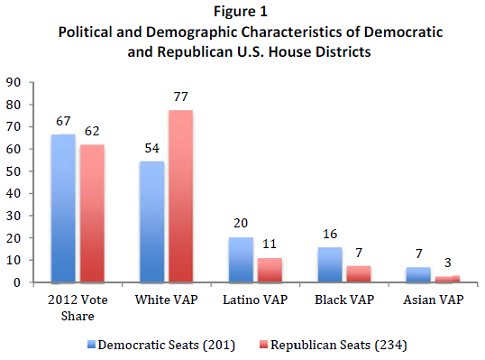
As a consequence, incumbent House members of both parties often claim to be more concerned about primary challengers as opposed to a strong general election opponent from the opposition party. In particular, for Republicans who are concerned about a challenge from their right flank, the path of least resistance may seem to be to oppose any legislation that can be depicted as being either weak on security or providing “amnesty” to undocumented immigrants.
However, the pessimism embodied in these predictions overlooks three important points. First, polling suggests that immigration reform is not an animating issue for most Republican primary voters and most Republican voters generally support the same reforms as Latinos. Second, Latino population growth is occurring everywhere, including in GOP House districts. Third, developing expectations about members’ behavior in terms of average district characteristics obscures individual contexts where Republican incumbents are vulnerable and Latinos may be influential. So while voting age Latinos may have small presences in most Republican held districts, there are a significant number of districts where Latinos are positioned to affect outcomes in 2014 and by extension, partisan control of the House of Representatives.
To assess these dynamics, Tables 1 and 2 present district level analyses that examine all seats where the 2010 Latino voting age population either exceeds or approaches the 2012 margin of victory, as well as seats won by the opposition party’s presidential candidate.[2] All total, 44 Republican (Table 1) and 61 Democratic (Table 2) seats meet these criteria.[3] Each party’s seats are then placed into one of three tiers depending upon their vulnerability and potential affect that Latino voters can exert in 2014. Tables 1 and 2 also include columns detailing the incumbent’s 2012 margin of victory, the difference between President Obama and Mitt Romney’s vote share in the district, the district’s white and Latino voting age populations, and the member’s vote on funding for DACA.
Inspection of Table 1 indicates that there are 14 first tier and 10 second tier Republican districts where Latino voters could be decisive in 2014. As a consequence, if House Republicans opt for hardline immigration policies that are out of step not just with the preferences of Latino voters, but with the public more generally, then the party may push already vulnerable incumbents into untenable positions heading into 2014. Given that the Democrats need a net gain of just 17 seats to secure the majority, failure by the House Republicans to successfully navigate immigration legislation could prove quite costly for the GOP even if the vast majority of House Republicans win reelection with minimal competition.
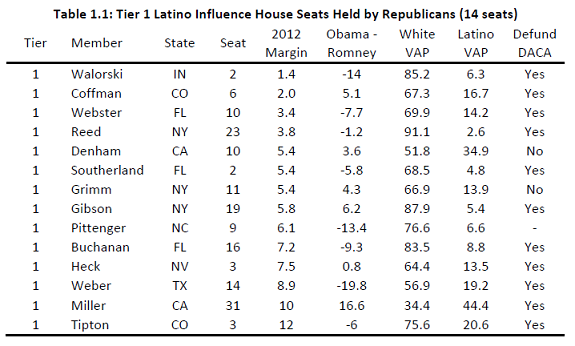
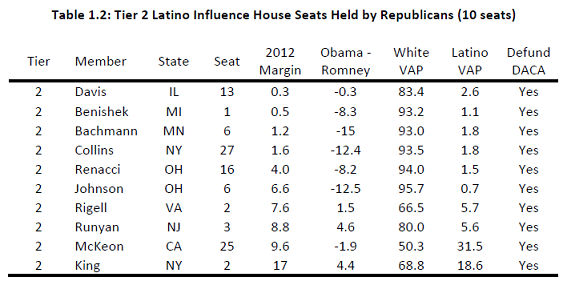
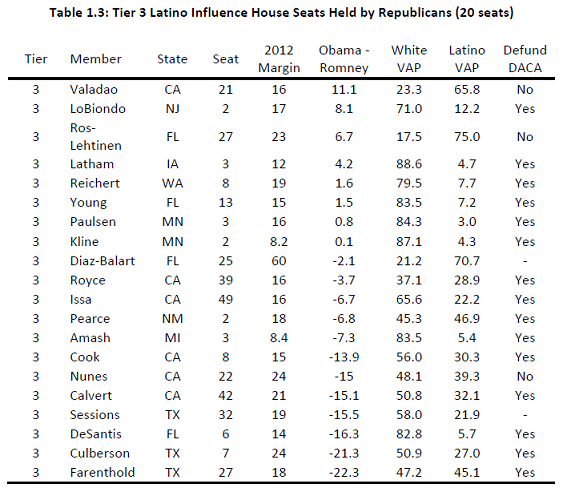
To this end, a consistent finding in Latino Decisions’ polling conducted throughout 2012 and 2013 is that the Republican Party has much to lose when it comes to immigration if it chooses to play an obstructionist role. However, by playing a constructive role in passing immigration reform that includes a pathway to citizenship, the GOP would be able to get beyond an issue that makes it nearly impossible for the party to make in-roads with Latino voters, while at the same time providing valuable political coverage for its most vulnerable House incumbents. If the party instead pushes legislation that focuses only on enforcement or that proposes to make an already cumbersome path to citizenship even more arduous, then Mitt Romney’s 2012 performance among Latino voters may be the GOP’s high watermark for quite some time.
As the data in Table 2 make clear, there is also great incentive for the Democrats to act on immigration reform. In fact, there are more Democratic districts where the Latino vote may be influential in 2014. However, much of this difference stems from the large number of Democratic seats with majority or near majority minority shares. Many Democratic House members with the largest 2012 margins of victory represent districts where voting age minorities constitute majority or near majorities. Thus, while Latino and minority voters may be “deterministic” in these districts, given the large 2012 margins and the strong Democratic tilt of these voters, it is difficult to think of scenarios where the outcomes of these 2014 House elections would be affected by short-term political forces.
Still, there are a significant number of vulnerable Democrats. Specifically, 19 Democrats are considered first tier targets for Republicans (six from districts carried by Romney) as compared to 14 Republicans (six of whom represent districts that President Obama won). Given that historically the president’s party loses on average 30 House seats during a midterm election, Democratic support for comprehensive immigration reform that includes a pathway to citizenship may insulate Democratic incumbents representing marginal seats. Thus, while the Democrats have been the recipients of strong support from Latino voters in recent election cycles, as polling by Latino Decisions highlights, continued turnout for Democrats by many Latinos is dependent upon the role that Democrats play in immigration reform.
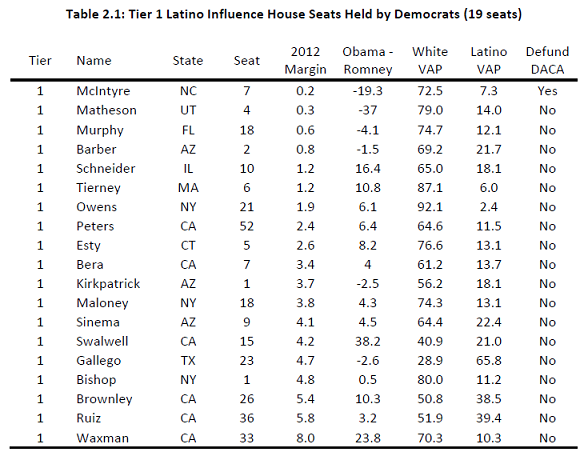

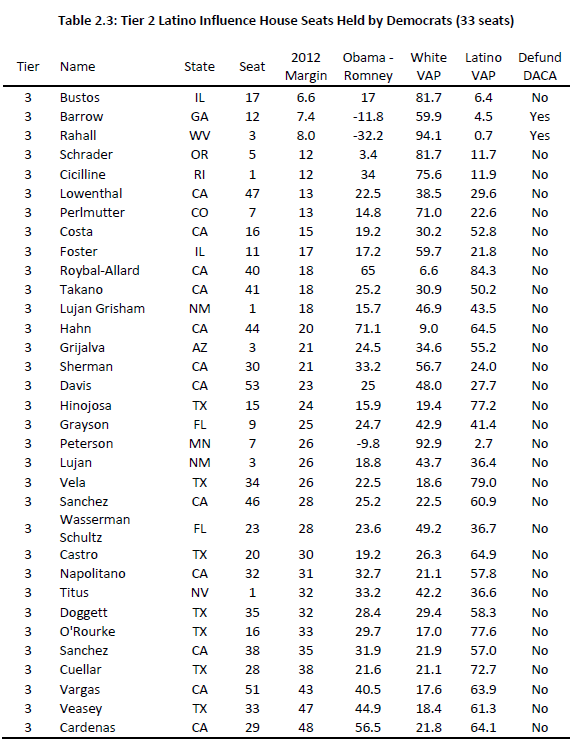
In sum, comprehensive immigration reform that includes a pathway to citizenship enjoys broad popular support and passed the Senate with both Republican and Democratic votes.
Moreover, as the analysis presented here suggests, both Republicans and Democrats in the House are vulnerable to Latino influence as there are sufficient House seats presently held by both parties where Latino voters can tilt the outcome in 2014 in a manner that determines which party controls the House of Representatives in 2015. Thus, despite ample commentary to the contrary, politicians from both parties have sufficient incentive to work together to produce a compromise immigration bill – a rare instance when good policy makes for good politics for both parties.
[1] For instance, during a recent appearance on NBC’s Meet the Press, Lindsey Graham (R-SC) noted that if “we don’t pass immigration reform, if we don’t get it off the table in a reasonable, practical way, it doesn’t matter who you run in 2016…We’re in a demographic death spiral as a party and the only way we can get back in good graces with the Hispanic community in my view is pass comprehensive immigration reform. If you don’t do that, it really doesn’t matter who we run in my view” http://tv.msnbc.com/2013/06/17/lindsey-graham-gop-faces-demographic-death-spiral-without-immigration-reform/
[2] There are three important caveats associated with this analysis. First, the white and Latino voting age populations are from the 2010 Census and thus, do not reflect subsequent population change. Second, voter turnout declines precipitously in midterm elections. Typically, around 60% of eligible voters turnout in presidential elections as compared to just over 40% in midterm elections, with the decrease in turnout traditionally hurting the party of the sitting president. Third, the competitiveness for a given House race is shaped by contextual factors (i.e., retirements, divisive primaries, and challenger quality) that at this point are largely unknown for most districts.
[3] The Democratic Congressional Campaign Committee (DCCC) recently identified 23 Republican districts “where constituents will demand progress on immigration, and where those pressures could persuade our Republican colleagues to support true comprehensive immigration reform.” All but four of these districts (Gerlach, Meehan, and Fitzpatrick of PA and Joyce of Ohio) are included in our analysis. We exclude these four because the districts were easily carried in 2012 (with the House Republicans running much stronger than Mitt Romney who narrowly won each district) and these districts contain small Latino voting age populations. In other instances, members identified by the DCCC may be supportive of a compromise immigration bill, but are not in particularly competitive electoral contexts such as Florida’s Diaz-Balart, Ros-Lehtinen, and Young, as well as California’s Valadao, New Mexico’s Pearce, and New Jersey’s LoBiondo. As a consequence, we place these districts in tier three.

